Quinoa's Molecular Secrets : How Acient Crops Hold Keys To Our Climate Future
focusHave you ever experienced the dizzy, breathless feeling of high-altitude sickness? When you’re not accustomed to it, high-altitude environments can feel overwhelmingly harsh. Acute Mountain Sickness (AMS) is the formal term for these symptoms, a common illness affecting those introduced to high altitudes without proper acclimatisation [1]. Biologically, our bodies struggle to adapt to reduced air pressure, making it difficult to absorb enough oxygen. Whilst adaptation occurs, we can rely on rest and other resources to ease the transition. In some ecosystems, however, this adaptation feels even more challenging. The Andes, one of the world’s largest mountain ranges, host breathtakingly beautiful yet hostile environments despite their diversity. Scarce water and daily temperature swings from freezing nights to scorching days, these are the conditions that communities face daily. While humans can create controlled environments to overcome these challenges, what about other organisms?
Life thrives in the extremes
Many plants and animals have thrived in the Andean mountains. Surprisingly, some plants flourish at high altitudes despite water scarcity, freezing temperatures, and soil salinity. Soil salinity might sound surprising, as high saline concentrations are usually associated with marine environments. Millions of years ago, parts of the Andes were covered by ancient seas, and salt deposits from these prehistoric oceans persist even at high elevations [2]. This salinity is intensified by the low humidity and intense solar radiation at altitude, which increase water evaporation and cause salts to concentrate at the soil surface. From a plant biology perspective, these adaptations are astonishing since these conditions typically inhibit growth. In fact, high-elevation habitats in the world’s major mountain ranges contain remarkable plant biodiversity at both local and global scales [3]. Among these remarkable species is the genus Adesmia, endemic to arid and semi-arid high-Andean regions of Chile, Argentina, Bolivia, and Peru. It forms open communities at altitudes between 1,500 and 3,700 metres above sea level [4], some examples of species belonging to this genus can be seen in Figure 1. These plants grow wild in the mountains, and whilst environmentally important, they aren’t cultivated as crops. But can crops actually grow at these altitudes? The answer is yes; meet quinoa.
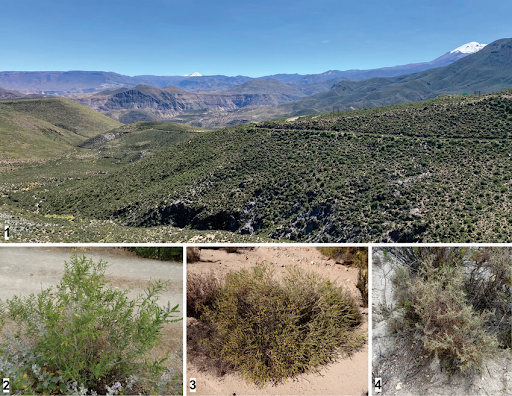 Figure 1. Shrubs of the South American genus Adesmia DC. (Fabaceae) co-occurring in the Andes of northern Chile (1) typical landscape near Socoroma Village at about 3400 m elevation (2) Adesmia verrucosa Meyen (3) Adesmia atacamensis Phil. (4) Adesmia spinosissima Meyen [4].
Figure 1. Shrubs of the South American genus Adesmia DC. (Fabaceae) co-occurring in the Andes of northern Chile (1) typical landscape near Socoroma Village at about 3400 m elevation (2) Adesmia verrucosa Meyen (3) Adesmia atacamensis Phil. (4) Adesmia spinosissima Meyen [4].
Quinoa: the ancient superfood
Chenopodium quinoa, commonly known as quinoa, is a crop native to the Andean region of South America, where it has been cultivated for 7,500-8,000 years. The domestication of this plant enabled Andean civilisations to flourish [5]. Today, it remains crucial for Andean farmers, particularly in Bolivia and Peru. Quinoa is remarkable because it thrives at altitudes of approximately 2,500-4,000 metres above sea level. Moreover, it can survive on as little as two inches of annual rainfall, not uncommon in the semi-arid Andes. It’s also frost-resistant. In recent years, quinoa’s popularity has expanded globally due to its resistance to adverse conditions and adaptability to diverse climates and soils. Additionally, the discovery of its high nutritional value has increased global consumption across Europe and Asia [6]. This positions quinoa as an intriguing crop for vulnerable areas where climate change threatens other crops. Quinoa has even been considered ideal for space exploration missions. Given its importance, the next question is: how does quinoa adapt to these conditions?
The molecular arsenal: stress proteins
Quinoa has developed various molecular, morphological, and physiological strategies to overcome abiotic stresses. The big picture involves physiological and morphological changes that depend on the stressor type. For example, during droughts, quinoa adapts its root and leaf size, altering its growth cycle. Similarly, water loss is minimised physiologically by closing stomata (leaf pores) [7]. But what about the molecular mechanisms behind these changes? The answer: stress-activated proteins.
Heat shock proteins: the cellular protectors
The Heat shock protein 70 (Hsp70) family consists of highly conserved proteins found in all organisms, including bacteria, plants, and animals. They assist in protein folding, acting as molecular chaperones. They prevent denatured protein aggregation, help protein translocation into organelles, and assist in protein degradation. These proteins are essential for cellular protection against stress conditions like heat shock and hypoxia, where they provide cytoprotection and protein folding assistance. But how exactly do Hsp70 proteins protect cells during stress? When environmental stresses like drought or heat cause cellular proteins to misfold, these damaged proteins can clump together, disrupting vital cellular processes such as photosynthesis, metabolism, and membrane transport. Hsp70 proteins act like cellular repair crews, using energy from ATP to grab these misfolded proteins and reshape them back into their functional forms. This prevents the formation of toxic protein aggregates that would otherwise kill the cell. Additionally, Hsp70 proteins help maintain the integrity of cellular membranes and organelles, which are particularly vulnerable during stress conditions. Hsp70 proteins have an average molecular weight of 70 kilodaltons (kDa) [8]. An illustration of Hsp70 can be seen in Figure 2.
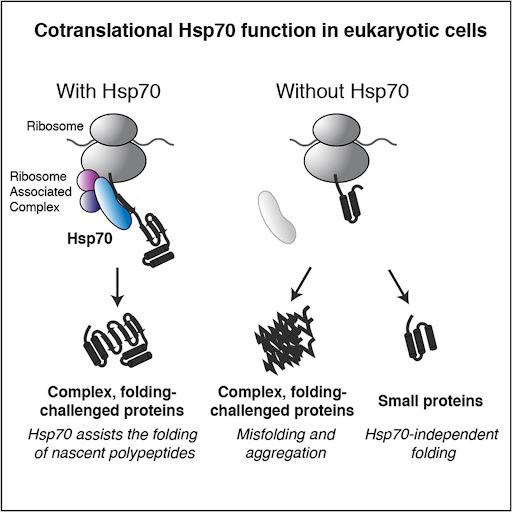 Figure 2. Hsp70 chaperone assists nascent proteins in achieving their correct conformations during folding. In the absence of Hsp70, proteins misfold and subsequently form aggregates. Small proteins can fold correctly even without Hsp70 assistance [8].
Figure 2. Hsp70 chaperone assists nascent proteins in achieving their correct conformations during folding. In the absence of Hsp70, proteins misfold and subsequently form aggregates. Small proteins can fold correctly even without Hsp70 assistance [8].
Given their broad functions, some Hsp70 proteins are expressed during stress conditions, while others are expressed under normal cellular conditions [9]. Several Hsp70 proteins have been identified during abiotic stresses in plants, and one study identified sixteen Hsp70 members in the quinoa genome. In the InterPro database, there’s an entry called “Heat shock protein 70 family” IPR013126 (Figure 3) where researchers can easily access a comprehensive list of Hsp70 protein sequences available in UniProt.
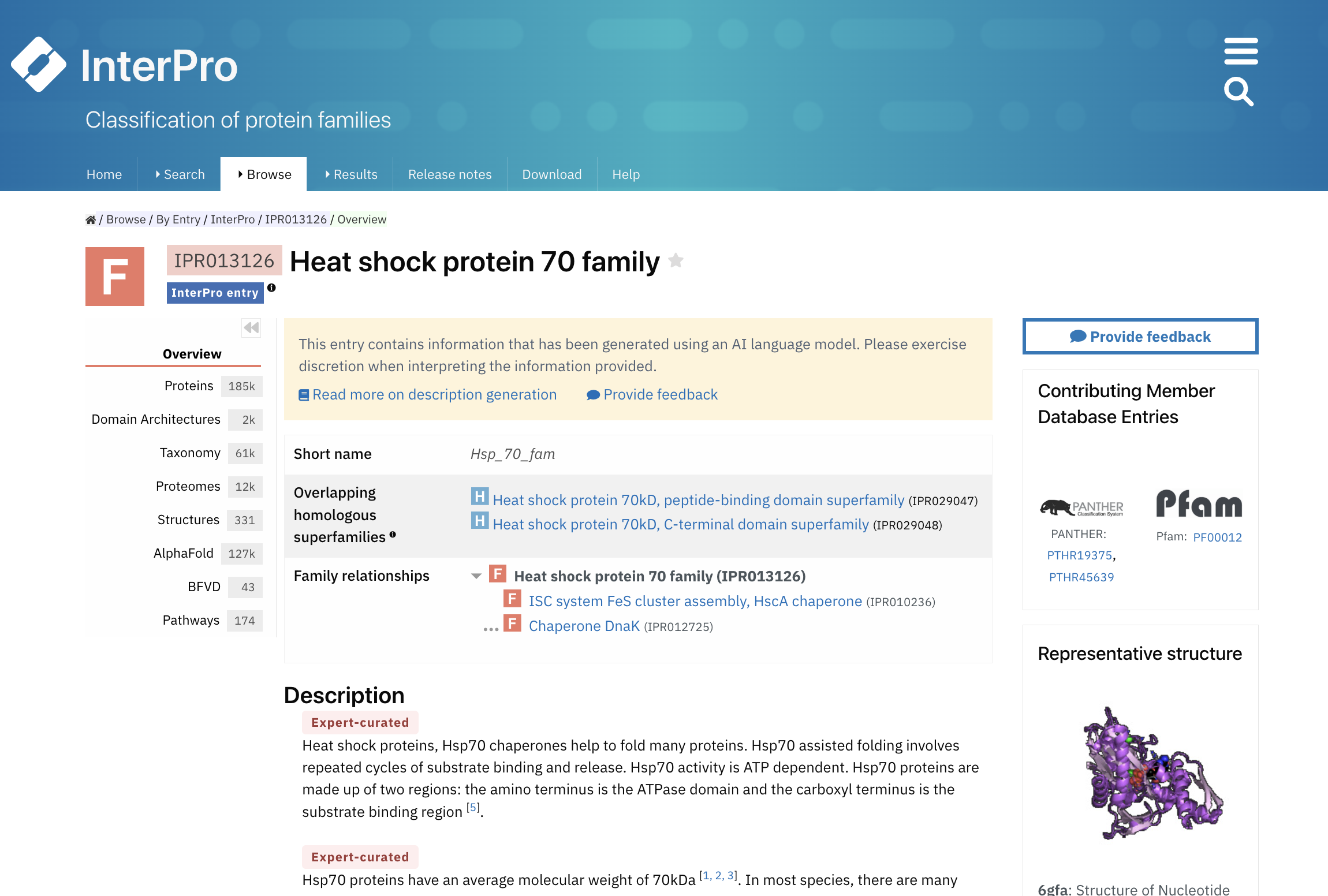 Figure 3. Interpro Page for Heat shock protein 70 family IPR013126.
Figure 3. Interpro Page for Heat shock protein 70 family IPR013126.
This entry encompasses Hsp70 proteins from both eukaryotes and prokaryotes, but users can filter by taxonomy to focus specifically on quinoa proteins. This is accomplished by selecting the Proteins tab and searching for the desired keyword, as shown in Figure 4.
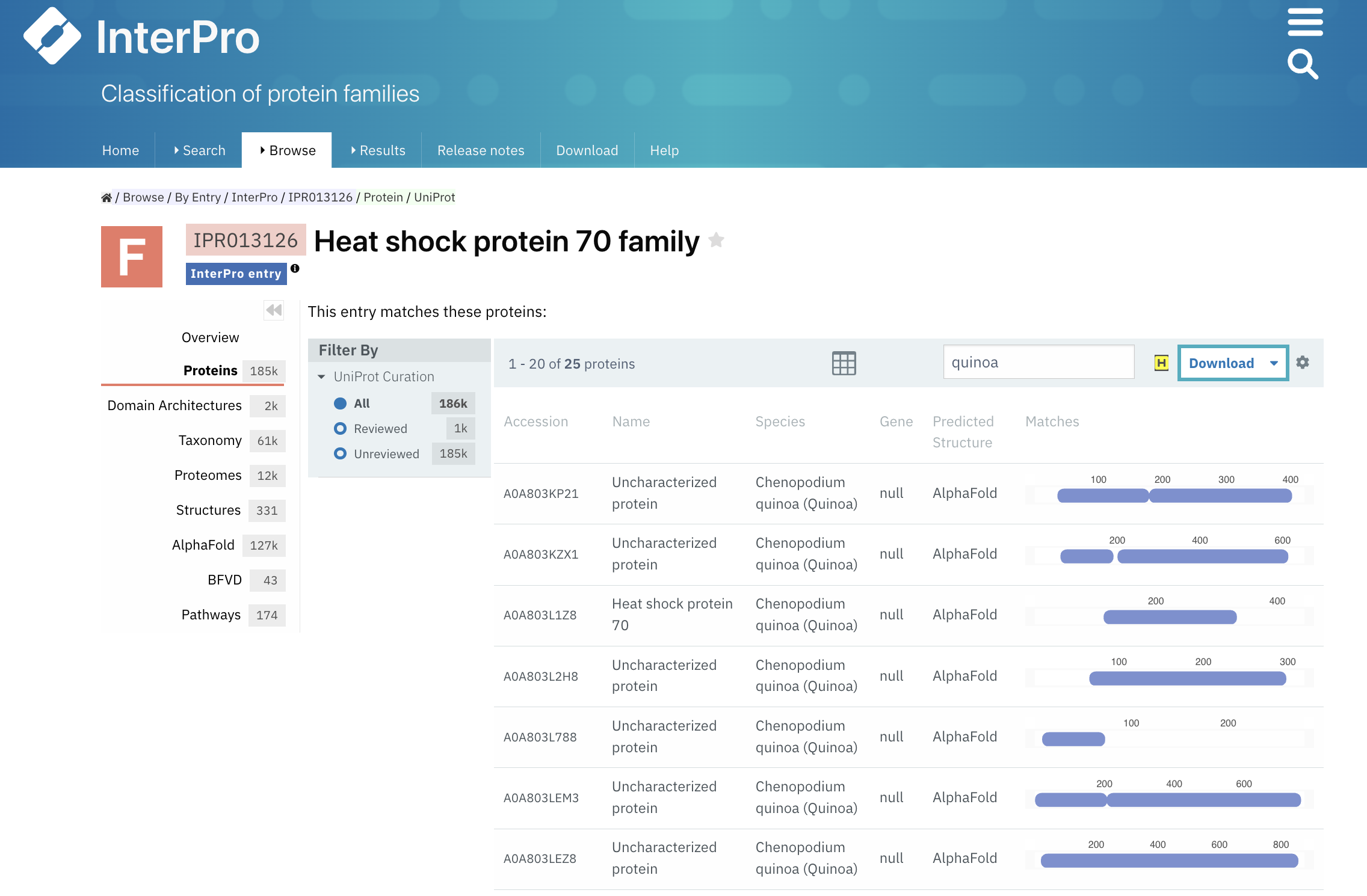 Figure 4. InterPro page with a list of the quinoa sequences in UniProtKB that belong to the HSP70 family.
Figure 4. InterPro page with a list of the quinoa sequences in UniProtKB that belong to the HSP70 family.
Fighting environmental stress: the Hsp70 response
Drought tolerance
Drought kills plants through dehydration effects, involving changes in water gradients and concentrations. Consequently, irreversible damage to cell membranes can occur, compromising plant stability. As mentioned, quinoa requires minimal water volumes, making it easier to grow in arid regions.One response during drought stress is quinoa’s ability to reduce photosynthesis. These changes are partly driven by various heat shock protein expressions. In one study [9], researchers induced drought stress in quinoa tissues and measured Hsp70 gene expression using qPCR (quantitative polymerase chain reaction, a technique measuring gene activity). Several genes were upregulated during stress, as shown in Figure 5.
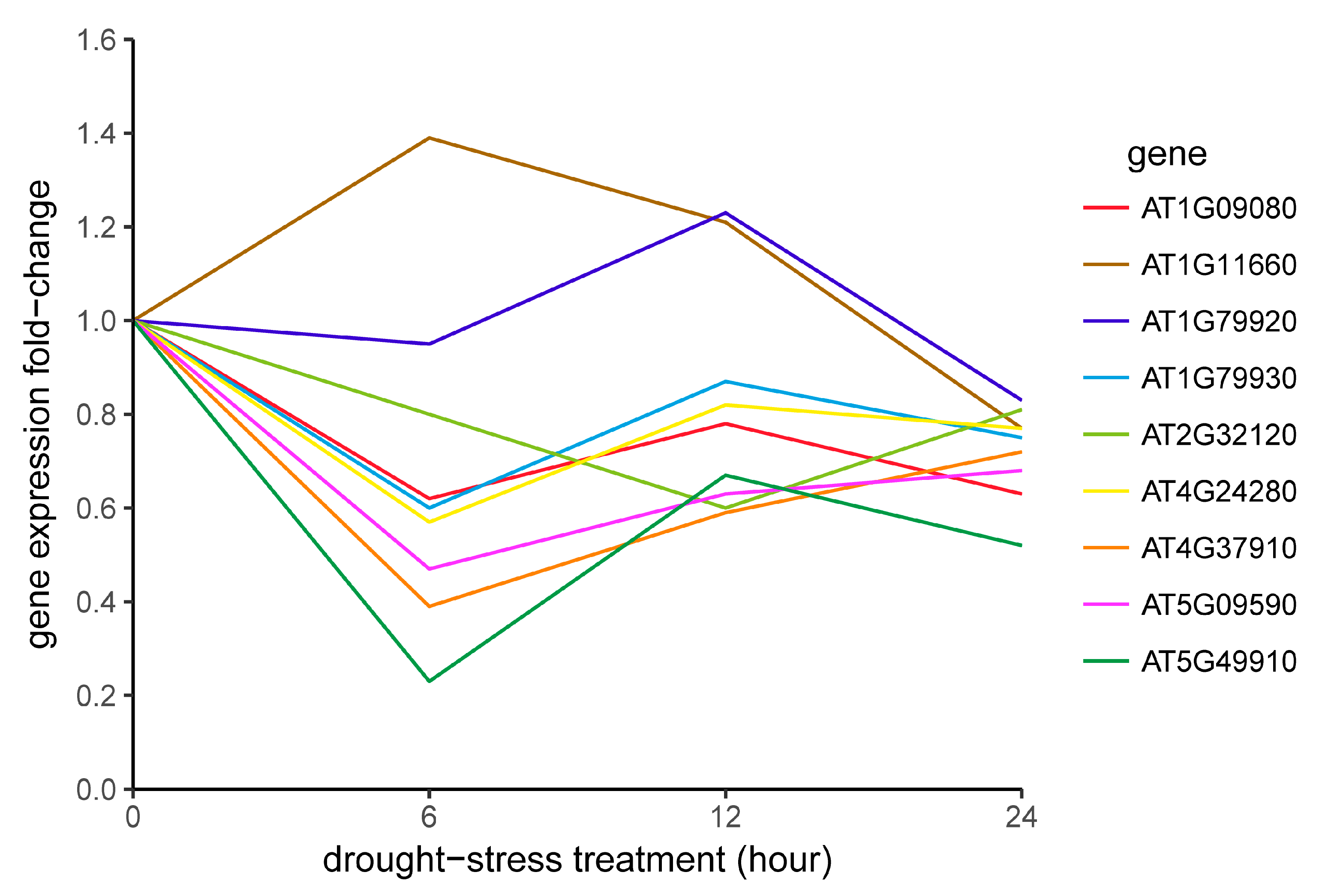 Figure 5. Athsp70 gene expression profiles in response to drought treatment [9].
Figure 5. Athsp70 gene expression profiles in response to drought treatment [9].
However, it’s important to note that whilst these studies demonstrate a correlation between Hsp70 expression and stress tolerance, they don’t definitively prove that increased Hsp70 levels directly cause improved drought survival. The upregulation could be a consequence of stress rather than the primary protective mechanism, or Hsp70 might work alongside other molecular pathways. More research is needed to establish definitive causal relationships and understand the precise mechanisms behind quinoa’s drought response.
Salt tolerance
Similar to drought stress, salt also causes dehydration. However, salt can change membrane potentials, allowing toxic ions to enter plant cells, disrupting normal plant functions. Quinoa’s first response is modulating ion homeostasis to regulate salt concentration. Simultaneously, antioxidant activity increases along with ABA (abscisic acid) expression, a key plant stress hormone [11]. Heat shock proteins are also involved in this response. RNA-seq analysis (a technique sequencing expressed genes) showed that heat shock protein gene families were upregulated during salt stress [12]. Whilst this suggests they have a protective role, establishing direct causation requires additional experimentation. Protein-level studies and functional analyses are still needed to confirm whether these proteins directly enhance salt tolerance or are simply responding to cellular damage.
Temperature tolerance
Climate stresses are important factors determining plant growth. Generally, plants survive drastic temperature changes by ensuring cell membrane integrity. In cellular contexts, high temperatures can cause protein denaturation [11]. Hsp70 proteins are vital in this process, as their main role is protein refolding. They protect cellular structures and stabilise membranes. A study exposing quinoa leaves to high temperatures (40°C) identified Hsp70/Hsp90 as upregulated genes, suggesting crucial roles in heat tolerance (Figure 6) [13].
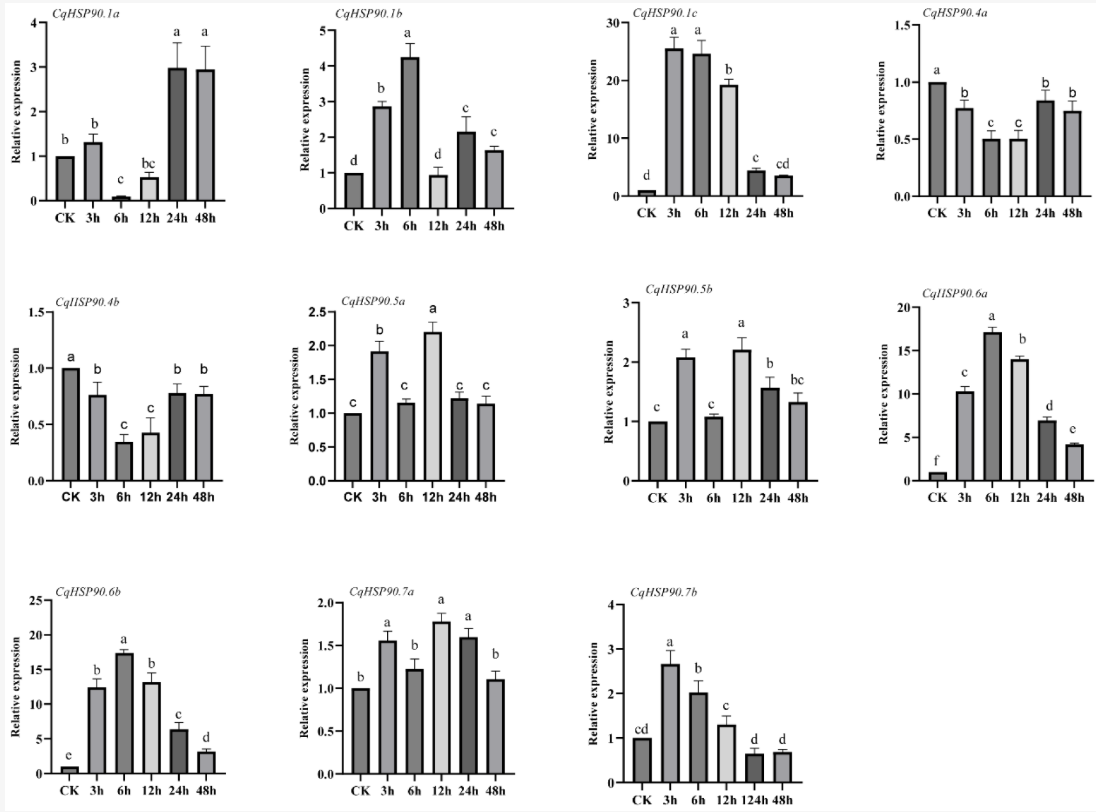 Figure 6. Expression pattern analysis of CqHSP90 genes under heat stress. The mean expression levels and standard deviations were calculated using data from three biological replicates. The vertical bars indicate the standard deviation. The time points were 0 (CK), 3, 6, 12, 24, and 48 h, respectively [13].
Figure 6. Expression pattern analysis of CqHSP90 genes under heat stress. The mean expression levels and standard deviations were calculated using data from three biological replicates. The vertical bars indicate the standard deviation. The time points were 0 (CK), 3, 6, 12, 24, and 48 h, respectively [13].
These findings highlight the need for further research, as the exact mechanism of Hsp70 is still unclear. To develop hypotheses for future experiments, researchers could examine the protein structure of quinoa Hsp70, either through available experimental structures or AlphaFold predictions. The InterPro database provides convenient access to such structural information via the structure tab for any given entry and also allows visualisation of other functional domains within the same protein. For example, one representative domain in a predicted Hsp70 protein from quinoa A0A803L1Z8 is the Actin-like ATPase domain IPR043129 (Figure 7), which shows how Hsp70 proteins utilise ATP for protein folding.
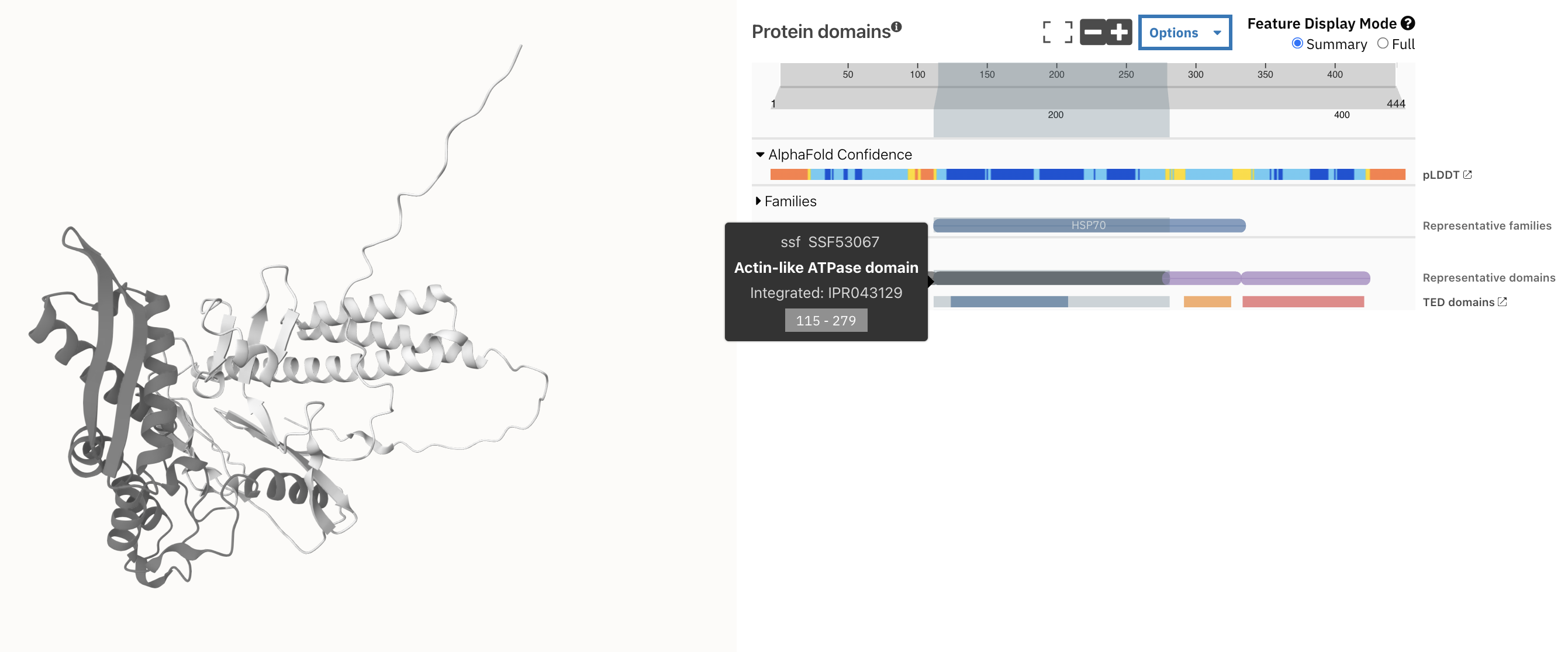 Figure 7. InterPro AlphaFold tab for predicted Heat shock protein 70 (A0A803L1Z8) in quinoa.
Figure 7. InterPro AlphaFold tab for predicted Heat shock protein 70 (A0A803L1Z8) in quinoa.
Beyond heat shock proteins
While Hsp70 proteins are fascinating, they represent just one part of quinoa’s molecular toolkit for stress resistance. Quinoa also resists freezing temperatures. In one study [14], researchers screened 11 co-expression modules closely related to low-temperature stress resistance and identified core genes involved in cold tolerance, including members of the AP2/ERF family IPR036955. These cold-resistance proteins tell a similar story to the Hsp70 research; we can identify the molecular players, but their exact mechanism is still unclear. If we search for quinoa in the Proteins tab of IPR036955, we can see the full list of AP2/ERF proteins. Navigating the structure could hint at the mechanisms behind these proteins. For instance, we can explore the AlphaFold structure prediction of A0A803KM00 (a protein belonging to the AP2/ERF family). For complete visualisation of domains and structure, we can navigate to the AlphaFold tab and select the split full-screen icon in the bottom right corner under the AlphaFold 3D structure. Interestingly, there is a domain named “DNA-interacting domain” IPR016177 (highlighted in Figure 8), which suggests these proteins may interact with DNA and other proteins to activate the cold resistance response.
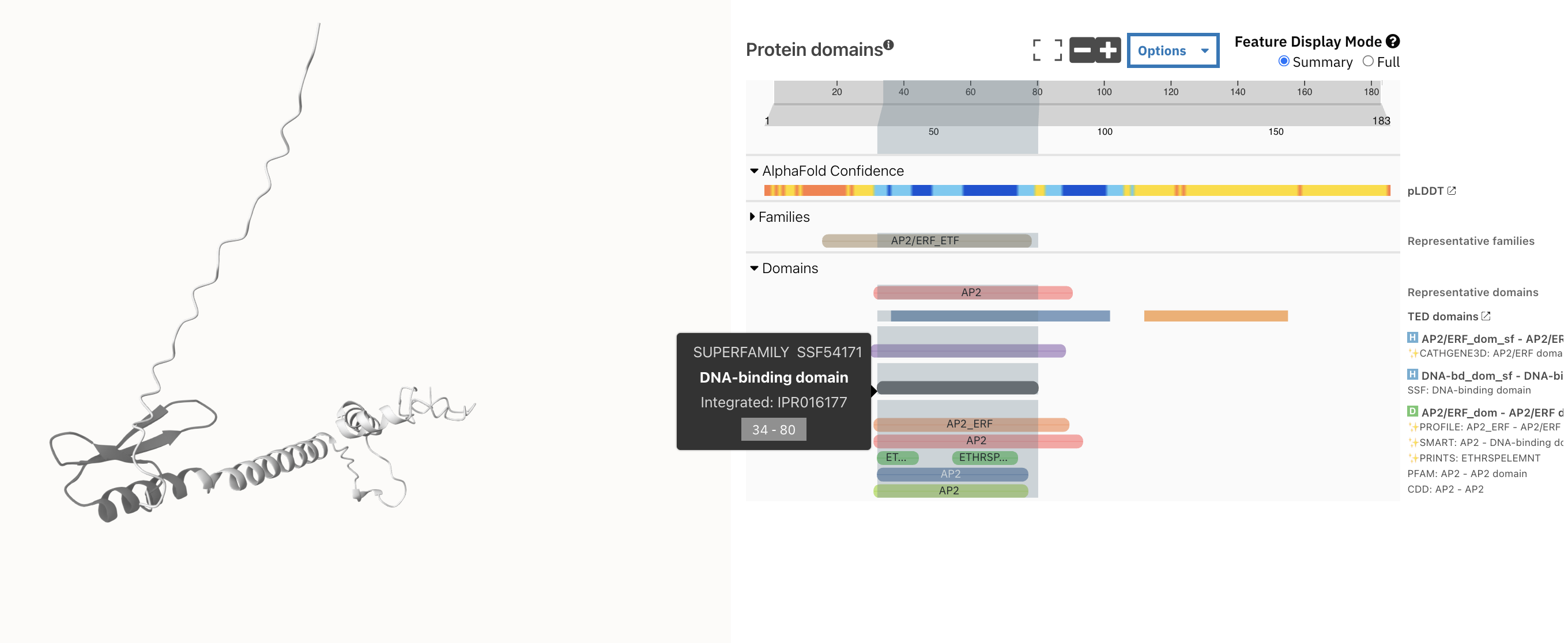 Figure 8. InterPro AlphaFold tab for predicted AP2/ERF domain-containing protein (A0A803KM00) in quinoa.
Figure 8. InterPro AlphaFold tab for predicted AP2/ERF domain-containing protein (A0A803KM00) in quinoa.
Climate change, food security, and future directions
Quinoa shows how traditional crops can inform modern agricultural strategies. Thanks to comprehensive studies of this crop and accessible protein databases like InterPro, we can further explore and understand the proteins behind quinoa’s environmental stress resistance. As climate change intensifies environmental stresses on agriculture, understanding these proteins becomes increasingly valuable. Quinoa’s Hsp70 and related stress-resistance proteins could potentially improve breeding programmes for other crops or guide the development of climate-resilient varieties. However, significant challenges remain. Laboratory findings about protein function must be validated through field trials across different environments. Moreover, quinoa’s practical limitations, including processing requirements, yield variability, and economic barriers, need addressing before it can meaningfully contribute to global food security. The real value of quinoa research may lie not in the crop itself but in what its stress-resistance mechanisms can teach us about developing more resilient agricultural systems.
References
- Taylor, A. (2011). High-altitude illnesses: Physiology, risk factors, prevention, and treatment. Rambam Maimonides Medical Journal, 2(1). https://doi.org/10.5041/rmmj.10022
- Pueyo, J., Demergasso, C., Escudero, L., Chong, G., Cortéz-Rivera, P., Sanjurjo-Sánchez, J., Carmona, V., & Giralt, S. (2021). On the origin of saline compounds in acidic salt flats (Central Andean Altiplano). Chemical Geology, 574, 120155. https://doi.org/10.1016/j.chemgeo.2021.120155
- Arroyo, M. T., & Cavieres, L. A. (2013). High-Elevation ANdEAN ecosystems. In Elsevier eBooks (pp. 96–110). https://doi.org/10.1016/b978-0-12-384719-5.00428-7
- Hadad, M. A., Flores, D., Gallardo, V., Roig, F. A., González-Reyes, Á., & Chen, F. (2021). Dendroclimatic potential of the Adesmia pinifolia shrub growing at high altitude in the Andes foothills. Dendrochronologia, 72, 125919. https://doi.org/10.1016/j.dendro.2021.125919
- Bonifacio, A. (2019). Improvement of Quinoa (Chenopodium quinoa Willd.) and Qañawa (Chenopodium pallidicaule Aellen) in the context of climate change in the high Andes. Ciencia E Investigación Agraria, 46(2), 113–124. https://doi.org/10.7764/rcia.v46i2.2146
- Basantes-Morales, E. R., Alconada, M. M., & Pantoja, J. L. (2019). Quinoa (Chenopodium quinoa Willd) Production in the Andean Region: Challenges and Potentials. Journal of Experimental Agriculture International, 1–18. https://doi.org/10.9734/jeai/2019/v36i630251
- Ain, Q. T., Siddique, K., Bawazeer, S., Ali, I., Mazhar, M., Rasool, R., Mubeen, B., Ullah, F., Unar, A., & Jafar, T. H. (2023). Adaptive mechanisms in quinoa for coping in stressful environments: an update. PeerJ, 11, e14832. https://doi.org/10.7717/peerj.14832
- Mayer, M. P., & Bukau, B. (2005). Hsp70 chaperones: Cellular functions and molecular mechanism. Cellular and Molecular Life Sciences, 62(6). https://doi.org/10.1007/s00018-004-4464-6
- Liu, J., Wang, R., Liu, W., Zhang, H., Guo, Y., & Wen, R. (2018). Genome-Wide Characterization of Heat-Shock Protein 70s from Chenopodium quinoa and Expression Analyses of Cqhsp70s in Response to Drought Stress. Genes, 9(2), 35. https://doi.org/10.3390/genes9020035
- Ni, Z., Liu, N., Yu, Y., Bi, C., Chen, Q., & Qu, Y. (2021). The cotton 70-kDa heat shock protein GhHSP70-26 plays a positive role in the drought stress response. Environmental and Experimental Botany, 191, 104628. https://doi.org/10.1016/j.envexpbot.2021.104628
- Dehghanian, Z., Ahmadabadi, M., Lajayer, B. A., Gougerdchi, V., Hamedpour-Darabi, M., Bagheri, N., Sharma, R., Vetukuri, R. R., Astatkie, T., & Dell, B. (2024). Quinoa: a promising crop for resolving the bottleneck of cultivation in soils affected by multiple environmental abiotic stresses. Plants, 13(15), 2117. https://doi.org/10.3390/plants13152117
- Hosseini, S. S., Ramezanpour, S. S., Soltanloo, H., & Seifati, S. E. (2023). RNA-seq analysis and reconstruction of gene networks involved in response to salinity stress in quinoa (cv. Titicaca). Scientific Reports, 13(1). https://doi.org/10.1038/s41598-023-34534-9
- Chen, F., Wang, W., Liu, W., Song, J., Chen, S., An, Y., Yin, H., & Guo, S. (2025). Identification of the Chenopodium quinoa HSP90 Gene Family and Functional Analysis of CqHSP90.1c and CqHSP90.6a Under High-Temperature Stress in Transgenic Arabidopsis thaliana. Plants, 14(17), 2770. https://doi.org/10.3390/plants14172770
- Zhang, L., Jiang, G., Wang, X., Bai, Y., Zhang, P., Liu, J., Li, L., Huang, L., & Qin, P. (2024). Identifying core genes related to Low-Temperature Stress resistance in quinoa seedlings based on WGCNA. International Journal of Molecular Sciences, 25(13), 6885. https://doi.org/10.3390/ijms25136885
